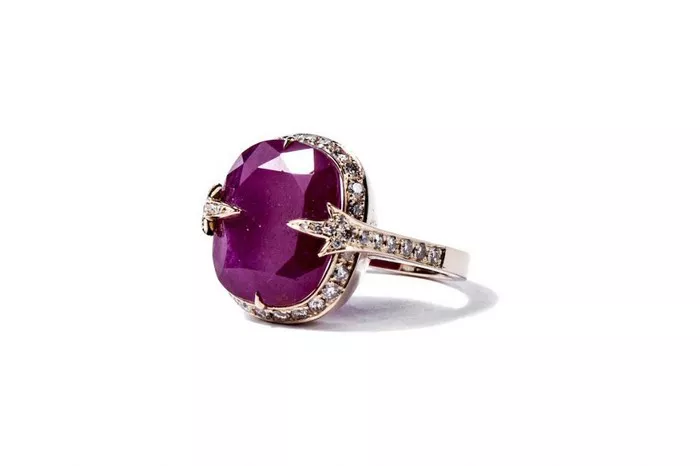Ruby, the king of gemstones, has always been admired for its vibrant red hue and luxurious appearance. In the world of jewelry, rubies are often associated with wealth, power, and romance. However, with the advancement of technology, lab-created rubies have entered the market, raising questions about their value. This article aims to provide a comprehensive guide on whether lab-created rubies are worth anything, exploring their origins, characteristics, value, and comparison with natural rubies.
Origins and Production of Lab-Created Rubies
Lab-created rubies, also known as synthetic rubies, are gemstones that are produced in a controlled laboratory environment. Unlike natural rubies, which are mined from the Earth’s crust, lab-created rubies are grown through a process called synthetic crystallization. This process involves simulating the high temperatures and pressures that occur naturally in the Earth’s mantle, where natural rubies are formed.
The production of lab-created rubies typically begins with a seed crystal, which is placed in a growth chamber filled with a molten flux containing the necessary elements for ruby formation, such as aluminum oxide and chromium. The chamber is then heated to extremely high temperatures and subjected to high pressures. Under these conditions, the elements in the flux rearrange themselves to form a crystalline structure that mimics the natural ruby.
The resulting lab-created ruby is then carefully cooled and polished to remove any imperfections and enhance its appearance. The entire process, from seed crystal to polished gemstone, can take several weeks to months, depending on the size and complexity of the ruby being produced.
Characteristics of Lab-Created Rubies
Lab-created rubies share many of the same physical and optical characteristics as natural rubies. Both types of rubies are composed of aluminum oxide, contain chromium impurities that give them their iconic red color, and exhibit a hardness of 9 on the Mohs scale, making them highly durable and scratch-resistant.
However, there are some subtle differences between lab-created and natural rubies that can be detected through careful examination. For example, lab-created rubies often have more perfect crystal structures and fewer inclusions (internal flaws) than natural rubies. Additionally, the color of lab-created rubies can sometimes be more uniform and intense than that of natural rubies, as the growth process can be precisely controlled to optimize color saturation.
Despite these differences, lab-created rubies are visually indistinguishable from natural rubies to the unaided eye. This similarity in appearance has led to their increasing popularity in the jewelry industry, as they offer a more affordable alternative to natural rubies without compromising on beauty or durability.
Value of Lab-Created Rubies
The value of lab-created rubies is a complex issue that involves multiple factors, including the cost of production, consumer demand, and the availability of natural rubies. Unlike natural rubies, which are subject to the laws of supply and demand and can fetch high prices due to their rarity and desirability, lab-created rubies are produced in controlled environments and are therefore more abundant and affordable.
The cost of producing lab-created rubies has decreased significantly over the years due to advancements in technology and increased production volumes. As a result, lab-created rubies are now available at more affordable price points, making them accessible to a wider range of consumers.
Consumer demand for lab-created rubies has also increased in recent years, driven by factors such as ethical concerns about mining natural gemstones, environmental sustainability, and the desire for high-quality, affordable jewelry. Many consumers are now willing to consider lab-created alternatives to natural rubies, particularly those who prioritize ethical sourcing and sustainability.
Despite their affordability and increasing popularity, lab-created rubies still hold a certain value in the jewelry market. While they may not fetch the same high prices as natural rubies, they are still highly valued for their beauty, durability, and ability to enhance the appearance of jewelry.
Comparison with Natural Rubies
When comparing lab-created rubies to natural rubies, it is important to consider both their intrinsic and extrinsic values. Intrinsic value refers to the physical and optical characteristics of the gemstone, such as its color, clarity, and hardness. Extrinsic value, on the other hand, refers to factors such as rarity, desirability, and cultural significance.
From an intrinsic value perspective, lab-created rubies and natural rubies are similar in many ways. Both types of rubies share the same physical and optical characteristics, making them visually indistinguishable to the unaided eye. Additionally, both types of rubies are highly durable and scratch-resistant, making them suitable for use in jewelry.
However, from an extrinsic value perspective, natural rubies hold a unique advantage. Due to their rarity and desirability, natural rubies are often associated with wealth, power, and romance, and are highly valued by collectors and investors. In contrast, lab-created rubies are more abundant and affordable, and are therefore less likely to appreciate in value over time.
Despite these differences, it is important to note that both lab-created and natural rubies have their own unique appeal and value. Lab-created rubies offer a more affordable and sustainable alternative to natural rubies, while natural rubies retain their cultural significance and desirability. Ultimately, the choice between lab-created and natural rubies depends on personal preference and budget.
Conclusion
In conclusion, lab-created rubies are indeed worth something, albeit not in the same sense as natural rubies. While they may not fetch the same high prices as natural rubies due to their abundance and affordability, they still hold a certain value in the jewelry market. Their beauty, durability, and ability to enhance the appearance of jewelry make them highly desirable among consumers, particularly those who prioritize ethical sourcing and sustainability.
Related topic:
- The Liberty Bell Ruby: A Symbol of American History?
- Natural Ruby Corundum Price: Essential Information for Buyers
- Ruby Seed Grown In Situ in Platinum Ring


